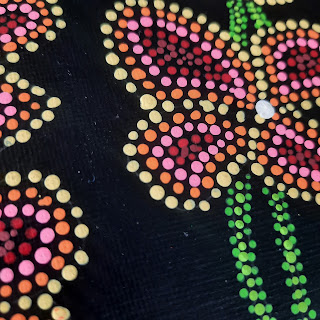
Every June, the Government of Canada honours the histories, achievements and resilience of First Nations, Inuit and Métis peoples, who have cared for this land since time immemorial.
I decided to do a Métis dot painting lesson with my Grade 7-9 students. Dot art is a contemporary art form inspired by Métis beadwork where beads are replaced with small dots of colourful paint.
One of my colleagues is Métis, so I asked her if she would be willing to do a presentation about her culture. She is very artistic and sews her own ribbon skirts as well as makes her own beading. She brought in some samples to share with the students and showed a beautiful presentation on the TV.
The term Métis refers to a collective of cultures and ethnic identities that resulted from unions between Aboriginal and European people in what is now Canada. In Canada, the Métis, with a population of 624,220 as of 2021, are one of three major groups of Indigenous peoples that were legally recognized in the Constitution Act of 1982, the other two groups being the First Nations and Inuit.
My province, Alberta, is the only Canadian province with a recognized Métis land base: the eight Métis settlements, with a population of approximately 5,000 people on 1.25 million acres and the newer Metis lands near Fort McKay, purchased from the Government of Alberta in 2017.
Our local IKEA had a great display on right now which explains some Metis history.
The Métis people became famous for their floral beadwork designs that were sewn onto clothing, moccasins, and other everyday objects. The Red River Métis are known for their prairie beadwork featuring colourful floral designs used to represent prairie wildflowers such as the prairie rose, wild strawberry, blue eyed grass, western red lily, and more. The popularity of floral beadwork designs on their clothing and leathers gave way to the Métis being referred to as the "Flower Beadwork People” by the Dakota and the Cree.
My Grade 7-9 students started off this lesson by looking at images of traditional beadwork:
Then, for a contemporary spin, they looked at the giant Métis dot paintings by Canadian artist and activist Christi Belcourt
Christi Belcourt. She takes inspiration from traditional Métis beadwork and creates large-scale paintings done entirely in dots, simulating thousands of beads. Her paintings create a link between the past and the present by transforming traditional Métis beadwork into contemporary paintings while still believing that “all life, even the rocks, needs to be treated with respect”. As a Métis visual artist with a deep respect for the traditions and knowledge of her people, the majority of her work explores and celebrates the beauty of the natural world.
So to start off, I bought a bunch of small canvas boards (from Dollarama) in slightly different sizes.
Most were about 4 x 7". I primed them all with black acrylic paint (2 coats).
I ordered dotting tools from Amazon and numbered each one, so students would choose the same one each class.
I also had handouts of patterns available.
Students chose their canvas size, then traced it onto scrap paper.
They drew their design within the shape.
Then they covered the back with graphite.
And then you transfer the drawing onto the black canvas using a ball point pen.
Students can use the drawing sheet to plan out colours.
Then students choose their colours and pour out small amounts of acrylic paint. They practice dotting first on scraps of black paper, in order to get the hang of it. This is an important step!!
I will say that my students really enjoyed this project! It takes a lot of patience and concentration, and I was proud of how well they did. The staff at my school were astounded by the finished artworks.

























































